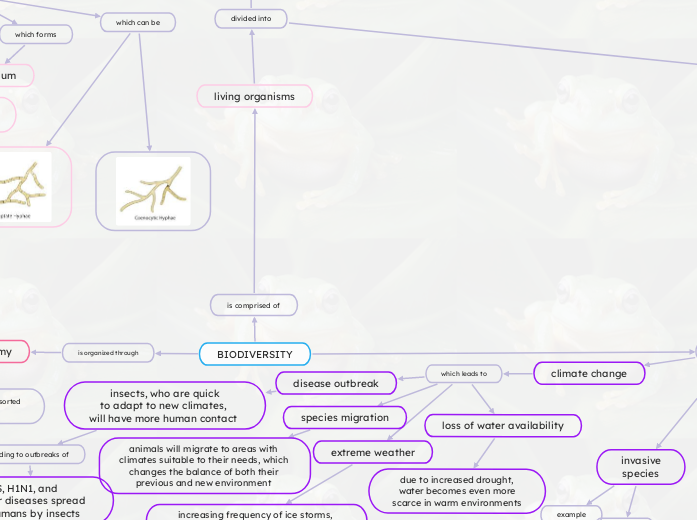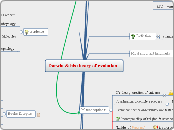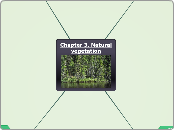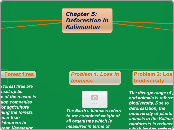the chart of taxonomy
BIODIVERSITY
is organized through
taxonomy
divided into taxes of
domain
kingdom
phylum
class
order
family
the most specific categorization; all members of a species share a common karyotype, morphology, and behavior
example: the genus lepus contain species from the leporidae family who are distinguished by their solitary lifestyles and larger size
example: all in felidae have flat faces, whiskers, large eyes & eyes, and round, flat faces
example: all in class 'rodent' are categorized by having incisors in the upper and lower jaws that continually grow
even more specific, categorizing based on similar traits. example: all in class amphibia have moist, smooth skin
more specific; divides
organisms with visible morphological or
evolutionary similarity
second broadest;
prokaryotes, protists,
fungi, plants, and animals
the broadest category;
includes bacteria,
archaea, and eukarya
which can be sorted
by
the study of form and
structure of organisms
based on
characteristics
such as
lacking a
backbone
invertebrates
sponges
seasponge
echinoderms
brittle star
cnidarians
a jellyfish
worms
an earthworm
arthropods
a musquito
mollusks
a snail
having a
backbone
known as
vertebrates
amphibians
a frog
reptiles
a komodo dragon
birds
a cardinal
mammals
a lion
symmetry
radial
symmetry
radiates out
from the centre of
the starfish
when symmetry
occurs out from
a central axis
asymmetrical
a sponge lacking
symmetry
a lack of
symmetry
in the body
bilateral
a butterfly with
bilateral symmetry
one side mirroring
the other
utilized by
Carolus Linneaus
who came up with
the system of
bionominal nomenclature
common name vs
binomial name of
the tiger
species
genus
which is
the study of form
and structure of
organisms
defined as
the study of naming,
identifying, and
classifying species
is comprised of
living organisms
divided into
eukaryotes
animalia
is divided into 8 major phyla,
including
chordata
tiger
different organs for
gas exchange
gills for
aquatic
species
lungs for
terrestial
species
nervous system with
dorsal nerve cord
Echinodermata
with
blue sea star
extracellular digestive
system; two openings
gas exchange
eyespots located at
the arms' tips
nerve ring
symmetry which is
radial as
adult
bilateral as larvae
Arthropoda
silverfish
extracellular digestive system
Tracheal system
which may consist of
gills in aquatic species
spiracles & tracheal tubes
open circulatory system
blood-covered organs
brain & ventral
nerve cords
mollusca
orange slug
extracellular
digestive system
mantle
cavity
containing
gills or lungs
closed
circulatory
system
large
brain
bilateral
symmetry
mesoderm,
endoderm,
ectoderm
annelida
leech
mesoderm, endoderm, ectoderm
extracellular
digestive
system
two openings
moist skin
absorption
of oxygen
closed circulatory system
dorsal and ventral
blood vessels
5 pairs of aortic arches
brain, ventral nerve chord,
and peripheral ganglia
coelum
platyhelminthes
tapeworm
three germ layers
mesoderm
closed pouch with one opening
simple excretory system
supported by
flame cells
cephalization
concentration of nerve cells at the end of the head
bilateral symmetry
cnidaria
reproduction
via
producing fertilized
eggs
budding
tentacles
to catch food
two body forms
motile medusa
tentacles & mouth at the bottom
immortal
jellyfish
sessile polyp
bubble coral
tentacles and mouth
at the top
non-moving
two germ layers
ectoderm
endoderm
to
obtain oxygen
gastrovascular
cavity
for
digestion
transporting
nutrients
simple nerve net
no coelum
radial symmetry
porifera
sea sponge
reproduce
via
sexual means
dispensing eggs and
sperm into water
asexual means
a piece of sponge that had broken off, which can grow into a new organism
buds
an asexually produced mass of cells that can grow into a new organism
lack germ
layers
has intracellular digestion
with single opening
digestion occurs at
a cellular level
obtains oxygen via
circulates nutrients via
diffusion
lack a coelum
lack nerve tissue
are non-symmetrical
plantae
which include
angiosperms
whose structure appears
as such
which can reproduce
cross
pollination
which one pollen from
one plant fertilizers an
egg in another plant
via means of seeed dispersal
self pollination
in which pollen from one plant is used to fertilize an egg cell in the same plant
spore formation
vegetative
propagation
dicots
floral parts in
multiples of
4 or 5
ringed vascular
bundles
netted veins
two cotyledons
leaf that protects
the embryo
monocots
scattered vascular
bundles
which have
flower parts
in multiples of 3
fibrous root system
paralell veins
one cotyledon
leaf that protects the embryo
coniferae
cedar
white pine
who reproduce via
cones
pollination occurs when
pollen transfers from a male cone to a female cone, producing a diploid zygote
males
contain male spores which become male gametophytes, containing pollen surrounding by cells
females
in which female spores become female gametophytes, which produce eggs
whose structure
consists
leaves, which can be
scale like
needle like
classified as
gymnosperms - non-flowering
seed plants
filincineae
in which examples include
eagle ferns
whose lifecycle consists
gametophyte
sporophyte
reproducing with sporangia, a capsule in which spores are formed
phloem
phloem
tissues to transport water
and food to other phloem
tracheophytes
in which examples
include
potato
corn
whose lifecycle
consists
seedbearing generation
seedless generation
xylem
tissues to transport water and food to other tissues
called phloem
tissues that transport sugars and proteins throughout the plant
bryophytes
in which
examples include
moss
whose life
cycle consists
haploid gametophyte
generation
in which haploid spores divide via mitosis to form gametes
diploid sporophyte
generation
in which they
produce spores
small reproductive parts
dispersed via the wind
a lack of
stems
roots
leaves
fungi
whose structure
comprises
hyphae
which forms
mycellium
an interwoven mat of
hyphae under the ground
accessibility to food, by
increasing its contact
to sources of nourishment
thin threads of cytoplasm enclosed in a layer of plasma membrane
covered by
cell walls with chitin, a sturdy and
flexible chemical compound
with
spores in between
which allows for
distribution of nutrients
across the body
whose major
phyla include
chytridomycota
ar
flagellated spores
Ascomycota
black knot
asci, which are sacs
with sexual spores
Basidiomycota
fly amanita
a basidium, which is a club shaped cell with sexual spores
Zygomycota
examples
bread mold (a) and its sporangia tips
which reproduce via
sexual spores, able to withstand extensive periods of cold or dry conditons
protists
which may
reproduce
sexually
fusing haploid gametes
asexually
via
asexual spores
fragmentation
binary fission
plant like
different from plants
because
unlike most plants,
lack roots, seeds,
and flowers
they can be
multicellular
OR unicellular
similar to plants
due to
the presence of
chloroplasts
an organelle that allows
for growth using light energy
multicellular
ex. seaweed
single celled
ex. diatoms
animal like
which are
different from
animals due to the fact
that they are
unicellular, unlike
animals
similar to animals
due to
an ability to move
and they can have
pseudopodia
cellular extensions
made of cytoplasm,
allows for movement in
desired direction
translates to "false feet"
cilia
small hairlike organelles
that can allow for
a swimming
type of motion
heterotrophic lifestyle
cannot make their
own food; subsist on eating
matter surrounding them
such as
paramecium
amoeba
fungus like
which are
similar to fungi because
producers of
spores
they feed on decaying matter
prokaryotes
monera
including two genera
archaebacteria
often described as
extremophiles
consisting of
acidophiles
archaea that live in acidic environments
halophiles
archaea that live in environments with high amounts of salt
methanogens
archaea that live in environments without oxygen
thermophiles
archaea that live in environments with temperature over 45 degrees
can be aerobic
capable of methanogenesis
metabolic process that results in the formation of methane
cube, pyramidal, stars, etc.
plates, some without cell walls
cell walls lack
peptidoglycan
eubacteria
which can be
tested for gram negativity/positivity with
gram staining
crystal violet dye is applied to the cell wall
negative doesn't retain the dye, turns pink
positive retains the purple dye
gram negative
layer of peptidoglycan is thin
gram positive
layer of peptidoglycan is thick
means of reproduction
include
endospores
a bacteria that can withstand long periods in unfavorable conditions
a wall like structure forms around them to build resistance
and
regenerates upon return of favorable condtions
transformation
in which the cell receives fragments of DNA from another cell
conjugation
in which two cells can exchange DNA, using plasmid rings that contain DNA
binary fission
the cell elongates and
a septum is formed,
from which the cell splits
living conditions
can be anaerobic
capable of living in environments
without oxygen
methods of nutrition
capable of photosynthesis
conversion of light energy into
usable energy for the bacteria
autotrophic
heterotrophic
morphology
shapes can include
cube, pyramidal, stars, etc.
cell walls with
peptidoglycan
an envelop that
protects the membrane
is affected by
climate change
loss of water availability
due to increased drought,
water becomes even more
scarce in warm environments
extreme weather
increasing frequency of ice storms, droughts, and floods
drastically affects biodiversity levels at rapid rates
species migration
animals will migrate to areas with
climates suitable to their needs, which
changes the balance of both their
previous and new environment
disease outbreak
insects, who are quick
to adapt to new climates,
will have more human contact
leading to outbreaks of
SARS, H1N1, and
other diseases spread
to humans by insects
invasive
species
zebra mussels
which reproduce
at a faster rate
than native mussels
lack natural predators
some areas have over a million mussels per square metre
can lower oxygen levels
in the waters
caused by
discharge of ballast
water in 1988
non-native
species are introduced to
an ecosystem
native species being competed
against for food and other
resources
native species being preyed upon
by invaders
causing
changes in the populations
of organisms in the ecosystem, creating imbalance
pollution
which may be caused by
pesticide
usage
which refers to
the use of toxic chemicals
in order to repel unwanted
species
pesticide runoff
pesticides reach bodies of water,
thus affecting the species that inhabit the water
risking the population
of non-targeted species
example
bee populations are
decreasing - one factor
is the use of pesticides in the flowers that they pollinate
increased difficulty of
reproduction
for flowering plants
scarcity of diet staples
for species that consume flowering plants
coal for electricity
generation
which causes emissions of
sulfur dioxide & mercury
acid rain
alters pH levels
of various habitats,
such as water, soil,
overexploitation
of
habitats
done via
deforestation
a process in which
forests are massively
cleared
which leads to
habitat loss
in which animals lose access to the
resources that they need to survive
in order to
make space
for construction
and resource
extraction
animals
done via hunting/fishing, with
examples such as
the extinction
of steller's sea cows
a marine mammal
that went extinct in the 18th century
due to
exploitation of their
fur, fat, and meat
shark finning
a barbaric practice in which
shark are caught, have their fins cut, and then are released back into
the ocean
which
threatens the survival of sharks, which are endangered
disease
which can be induced by
viruses
for example
bird flu
which affects respiratory, nervous, and digestive systems
can affect not only birds, but other animals, including humans
who may reproduce via
lysogenic cycle
virus incorporates its DNA into the chromosome of the bacteria
when the cell reproduces, the viral DNA is reproduced as well
lytic cycle
in which
the bacteriophage (bacterial attacking virus) attaches to the host cell, infiltrating it with viral DNA
the host cell is forced to make copies of the viral DNA and assemble viral proteins
once enough copies are there, the cell bursts, and thus new viruses are released and infect more cells
whose structure consists
tail fibres
which puncture bacteria
nucleic acid
a small piece of either RNA or DNA
protein coat
with patterns able to that
enable into a host cell
considered non-living because
unlike living organisms, they cannot reproduce on their own









